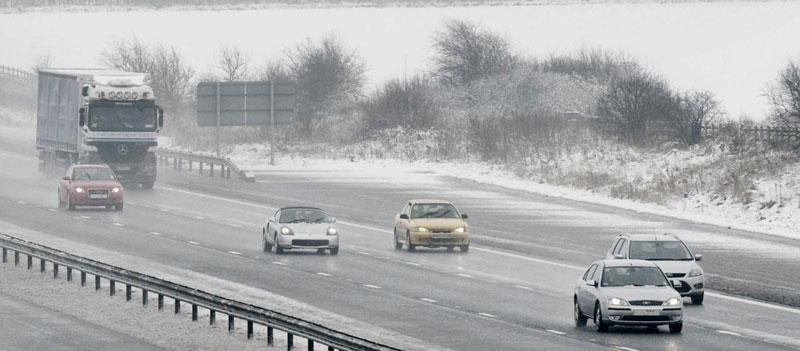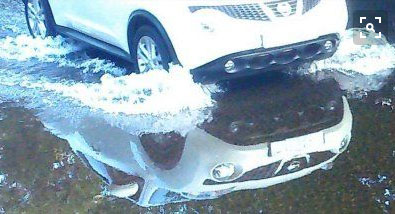Advice - winter driving

Whether travelling on busy streets or rural roads, as a driver or other road user, it is vitally important to make yourself visible to others.
Children and older people are particularly vulnerable at this time of year and should take extra care and brighten up by wearing something bright and reflective.
However, it’s not just pedestrians who need to be more careful. As the cold weather bites, drivers should be prepared to deal with ice, snow, rain and low sun which are all particularly hazardous in the winter season. Drivers should ensure they drive appropriately for the conditions and are prepared in advance for bad weather.
Winter driving advice from Highways England
Driving in severe weather: be prepared and be aware
Carry an emergency kit
Gather together the following items and pack in your vehicle at the start of the winter season. You never know when you might need them!
- Ice scraper and de-icer
- Torch and spare batteries – or a wind-up torch
- Warm clothes and blankets – for you and all passengers
- Boots
- First aid kit
- Jump leads
- A shovel
- Road atlas
- Sunglasses (the low winter sun and glare off snow can be dazzling)
Before you set off – check the latest traffic and weather
Have you planned your journey?
In severe and wintry weather it’s even more important to plan your journey. Highways England provides up to the minute traffic reports for its network of 4,300 miles of motorways and major A roads across England.
Just a few minutes checking information services before you set off can make all the difference to your journey.
Before you set off
The Highways England website includes the latest traffic reports, maps showing how the traffic is flowing on England’s motorways and major A roads, a motorway flow diagram, views from CCTV cameras, average speeds and the displays on motorway message signs.
Road and weather conditions may change, drive with care
When you’re on the road, pay attention to the changing road, traffic and weather conditions. Be ready to slow down and take more care if you need to, particularly on bends and exposed roads. Don’t be lulled into a false sense of security – even if you drive every day on the same stretch of road.
Additional information and advice on driving in adverse weather conditions is available in the Highway Code or by visiting the RoSPA page on winter driving.
Updates on the move
If you are away from your computer or have already set out on your journey, there are still lots of ways to get Highways England live traffic information.
On overhead message signs – motorway control centres will flash up important travel messages, including warning you of delays and advising of alternative routes. There are also automatic signs telling you how long it will take traffic to reach certain destinations at that time.
When you take a break
On long journeys, consider taking a break at regular intervals – and that’s an ideal time to check the traffic conditions on the road ahead.
While you are safely parked, check the latest information via your mobile phone, iPhone or laptop. Never stop on the hard shoulder to do this and never use your mobile phone while driving.

Driving in severe weather
Driving through snow and ice
Highways England looks after motorways and major A roads, and local authorities look after all the other roads. Both work as hard as they can to keep their networks clear during severe weather.
Stick to the main roads where you can and avoid exposed routes.
You should drive with care and respect the road conditions wherever you drive, but not every road can be treated. You need to take even more care driving on minor roads.
Even if the time and location of snowfall is perfectly forecast, it will still take time to clear the snow after it has fallen. Remember though, snow ploughs can’t get through if the road or motorway is full of stationary traffic. Give Highways England and local authority teams the space they need to do their job and help you on your journey!
Steep hills and exposed roads are also likely to present more challenging driving conditions in snow and ice, so if you could avoid these it might make your journey easier.
Make sure you can see and be seen. Clear snow and ice off all windows, lights and number plates.
Leave extra space between you and other vehicles. Take even more care looking out for others that may not be able to stop and be extra cautious at road junctions where road markings may not be visible
If you use a higher gear than normal it will help to avoid wheel spin on a slippery surface. Accelerate and brake gently to avoid skidding.
 Driving in rain and floods
Driving in rain and floods
When the road is wet it can take twice as long to stop. Slow down and maintain a safe distance from the vehicle in front.
If your vehicle loses grip, or “aquaplanes”, on surface water take your foot off the accelerator to slow down. Do not brake or steer suddenly because you have less control of the steering and brakes.
When faced with a flooded road, be very careful as you can’t always tell how deep the water is. Just 30cm of flowing water can wash a car away.
If you have no alternative but to drive through floods, drive slowly, use a low gear and try to keep the engine revving at a high rate. Move forward continuously to avoid stalling the engine. When driving an automatic vehicle, engage and hold in a low gear. And remember to test your brakes after driving through water; they may be ineffective.
Driving in fog
In reduced visibility, where you cannot see as much of the road ahead, you will need to slow down and drive more carefully. Use dipped headlights so that other drivers can see you.
Fog lights and full beam can dazzle other drivers. Use fog lights when it’s really thick (less than 100m visibility) and then don’t forget to turn them off when conditions improve.
Fog is often patchy so try not to speed up as soon as visibility improves. You could suddenly find yourself back in thick fog further up the road.
Driving in windy weather
Take extra care on the roads and plan your journey by checking the latest weather conditions. The traffic news, overhead motorway signs and Highways England digital information services will say if any roads or bridges are closed because of high winds.
Though high-sided vehicles are particularly affected by windy weather, strong winds can also blow other vehicles off course. This can happen on open stretches of road exposed to strong crosswinds, or when passing bridges, high-sided vehicles or gaps in trees.
Whatever the severe weather always adjust your driving according to the conditions.
Make sure you can see clearly and that you can be seen. Use at least dipped headlights in poor visibility – and don’t just rely on daytime running lights if you have them.
Check weather updates
Take weather conditions into account when planning your route by visiting The Met Office website or listening to local radio broadcasts.
Timing
Always allow extra time in severe weather. Listen to warnings or advice and consider whether or not your journey is essential.
If severe weather is forecast, can you plan your journey to travel before the worst of the weather? Or wait until it has passed? Or at least allow time after the snowfall for crews to do their work clearing the roads? It all helps.
Remember, in severe weather you will need to allow more time for your journey. If severe weather is forecast are you able to change your travel plans? Can you work at home, for example?
There can be lots of different pressures to make a journey – whether it’s the pressure to get to work, the pressure to make a delivery on time or the desire to see friends and family at Christmas. Remember none of these pressures are more important than your safety.
When a prolonged period of severe weather is on the cards, we can all help to ease the pressures by allowing extra time for that delivery, being prepared to take a little longer for our journey and being flexible in our planning.
Links to more advice and information
Highway Code (online)
The Highway Code has a section dedicated to driving in adverse weather.
RAC
Winter driving tips from preparing your vehicle to advice on driving in snow.
AA
Coping with cold, snow and ice.
RoSPA
Coping with the various seasonal weather hazards.
